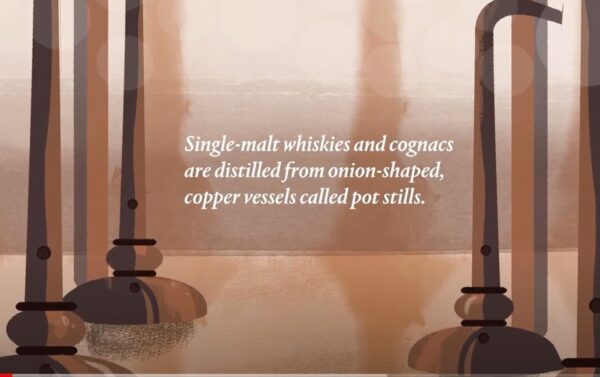GRAPE BRANDY
Brandy is anything distilled from fruit: apples, cherries, plums (slivovitz), pears. The most famous brandies are distilled from grapes: cognac, armagnac. Grape brandies are made all over: Armenia, South Africa, Chile, the USA.

You make brandy by crushing grapes and fermenting the juice into wine. The quality of the grapes, the way you crush them, how you ferment the juice, and how you store the finished wine before you distill it are all crucial factors

The photo is a rich fermentation for pisco at Piscologia. At Germain-Robin, it took 6 tons of grapes to make a barrel of brandy.

good distillation is an art. Here’s a quick YouTube: https://www.youtube. com/watch?v=igPBOkH_sWg. What the video leaves out (because single malt distillers don’t have access to the distillate as it comes from the still), is that at the beginning and end of each distillation, the distiller makes his “cuts”, separates the heads, (first part of the run, often with toxic alcohols) and the tails (at the end, when it starts tasting cooked) from the main body of the run. This, plus adjusting the heat (= the pace of the distillation). is where talent shows up. You do this every run, and if you get it just right every time, you’re making as good stuff as is possible with the wine you started with.

This is a longer video with Ansley talking about distilling aromatic wine grapes, giving an idea of the many complexities of the work

Doing this stuff well is pretty deep. Here’s Joe Corley of Germain-Robin thinking about a heads cut. If you don’t get it right on, you wish you had, every single run

Taking the heads into a small bucket at Germain-Robin. If you’re distilling really good grapes/wine, the heads cut is very small

A 1700-liter still at Tiffon, home of Maison Surrenne. Small stills make better brandy. The large cognac houses use enormous stills for their first distillations, but are compelled by regulation to use 2500-liter (660-gallon) stills for the second distillation. It is almost impossible to find a photograph of the huge ones
The Cognac region is cool and rainy. Its grapes don’t make good table wine, so they started making brandy. They double-distill using what is likely the world’s finest still, the alambique charentais, which yields elegant and subtle distillates. Soil characteristics are what matter, and there is great variation in cognacs from the strictly delimited growing regions. Unfortunately, cognac is now almost entirely commoditized, with huge distilleries (not open to the public) using huge stills for the first distillation (by law they have to use a 2500-liter still for the second distillation), a great deal of aging in tall vertical tuns instead of barrels. and liberal use of boisée (cognac steeped in oak chips to impart oak flavor) and sugar. There are still some wonderful cognacs, and we are fortunate to be working with Tiffon, the largest remaining family-owned house, which has a lot of great old cognacs in barrel. and Pierre de Segonzac, one of the last estate cognacs: they grow what they distill, in a modest vineyard at the center of the grande champagne district.
The French make plenty of column-still brandy, which sells in the US for about $14/bottle

Armagnac uses a potstill with a column mounted on top, so that the spirit is made in a single distillation. There are still excellent small-production armagnacs; the brandy tends to be fruitier than cognac, and not quite as subtle

Pisco is a grape brandy from Peru and Chile. In Peru, pisco has been declared an official national treasure and its production, restricted to specific grape varietals, is tightly regulated, to enforce the use of ancestral methods. Peruvians deeply resent that brandy can be made in Chile on column stills from whatever grapes and be called pisco. Here’s the Piscologia pot still. Go here to see how great pisco is made: About Pisco



